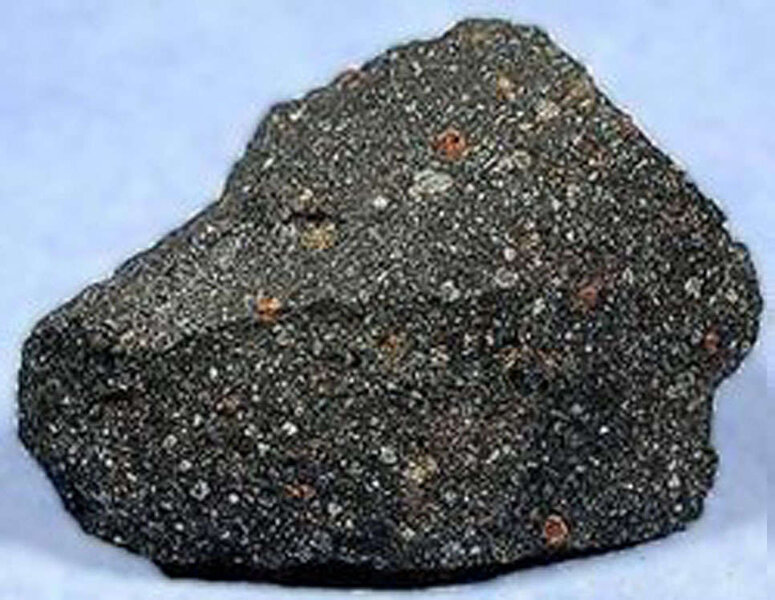Create a free profile to get unlimited access to exclusive videos, sweepstakes, and more!
Heating up meteorites could tell us more about exoplanet atmospheres and potential for life

Sometimes, the search for life starts with things that fall to the home planet from space.
Finding out what is floating around in a planet’s atmosphere can be an astronomical headache. Even the most advanced telescopes out there right now have issues distinguishing features of distant stars and their atmospheres from the exoplanets that transit them. There are theories on what could have been in the atmospheres of such planets when they were first forming, but now, a team of scientists who heated meteorites and analyzed the gases released found potential differences between theory and reality.
“Smaller rocky planets likely form their atmospheres through outgassing during their formation and later from subsequent tectonic processes like volcanism,” researcher Maggie Thompson of University of California, Santa Cruz told SYFY WIRE. “This outgassing process occurs because a rocky planet is heated due to radioactive decay, collisions, and leftover heat from the formation process.”
The primordial atmospheres of rocky planets like Earth may have been very different from what they were assumed to be. Thompson, planetary scientist Myriam Telus, and their team, who recently published a study in Nature Astronomy, found that the atmospheres of Earthlike planets in the early universe were more likely to form by gases that escaped from the surface. Billions of years ago, space was chaotic as objects smashed into other objects and either accreted into larger bodies or were flung into the void. Meteorites are the debris left over from that chaos.
Planets similar to our own were once thought to have gotten their atmospheres from the stellar nebula — the enormous cloud of gas and dust in which stars, planets, and moons formed. Previous models of exoplanet atmospheres also went with the assumption of stellar abundances. Meaning, the main gases in the atmosphere of the star (or stars) at the center of a planetary system would also be found in the atmospheres of most planets in that system. Applying a theory like this to the nascent solar system would give Earth a hydrogen and helium atmosphere similar to that of the Sun.
“Understanding the differences between our experimental results and the models is important because our experiments can reveal when kinetics effects are important to take into account in models,” Thompson said. “In our experiments, the meteorite composition is changing as outgassing occurs and gas species are released and removed, whereas the equilibrium models assume a closed system in which the gases are not removed.”
It is possible that some larger rocky planets had enough mass, and therefore enough gravity, to hang on to an atmosphere of gases from the stellar nebula. Most of them are believed to have lost that because they were too small or have had too many collisions. Killer radiation could have also obliterated nebular gas atmospheres.
So how did these planets manage to hold on to atmospheres that have survived for eons? The heat from both their violent formations and volcanic activity released gases trapped in rock, which accumulated into an atmosphere, but even models of this may be off when compared to Thompson’s findings.
There could be a margin for error either way. It might be that the lab experiments, which involved heating samples from three different CM-type carbonaceous chondrites (meteorites containing chondrules or spherical pieces of silicone-based rock) did not allow the time for enough reactions between gases to occur, which is why the results were showing much lower levels of H2. Hydrogen sulfide (H2S) also outgassed at higher temperatures than the models predicted. This could be due to the effects of kinetics — forces acting on certain processes. No N2 or methane were detected in the outgassing as the models had predicted, either.
“The absence of N2 is primarily due to the atmospheric adsorption correction we apply to the data to account for the possibility of contaminated N2 gas from Earth's atmosphere that is adsorbed by the meteorite samples,” Thompson said. “While we did not detect methane outgassing in this first study, we plan to investigate this further in the future to determine if methane may be outgassing from different meteorite samples since it is a prebiotically important molecule."
Because the materials that make up carbonaceous chondrites like the Aguas Zarcas meteorite, a piece of which was heated in the experiment, are common in the universe, outgassing could tell us whether an exoplanet’s early atmosphere was made of the stuff of Earth’s. Rocky debris found on white dwarves has shown the abundance of these materials. White dwarves are the cores of stars that burned out but were not large enough to go supernova, and have cooled off over time. Carbonaceous chondrites are also more likely to have preserved the chemical makeup of those early atmospheres because they did not completely melt like other meteorites.
Matches for what was in the air of our planet when it had just been born might give us candidates for future telescopes such as James Webb to observe for signs of habitability. Thompson believes they could.
“Measuring the outgassing compositions from meteorites can tell us about gas species that may exist early in a planet's atmosphere,” she said. “Some of those may be important for life.”



























